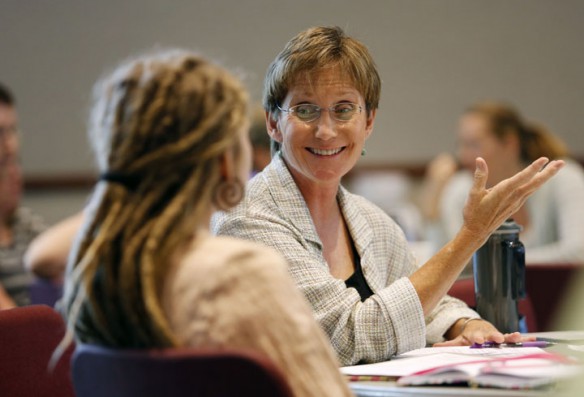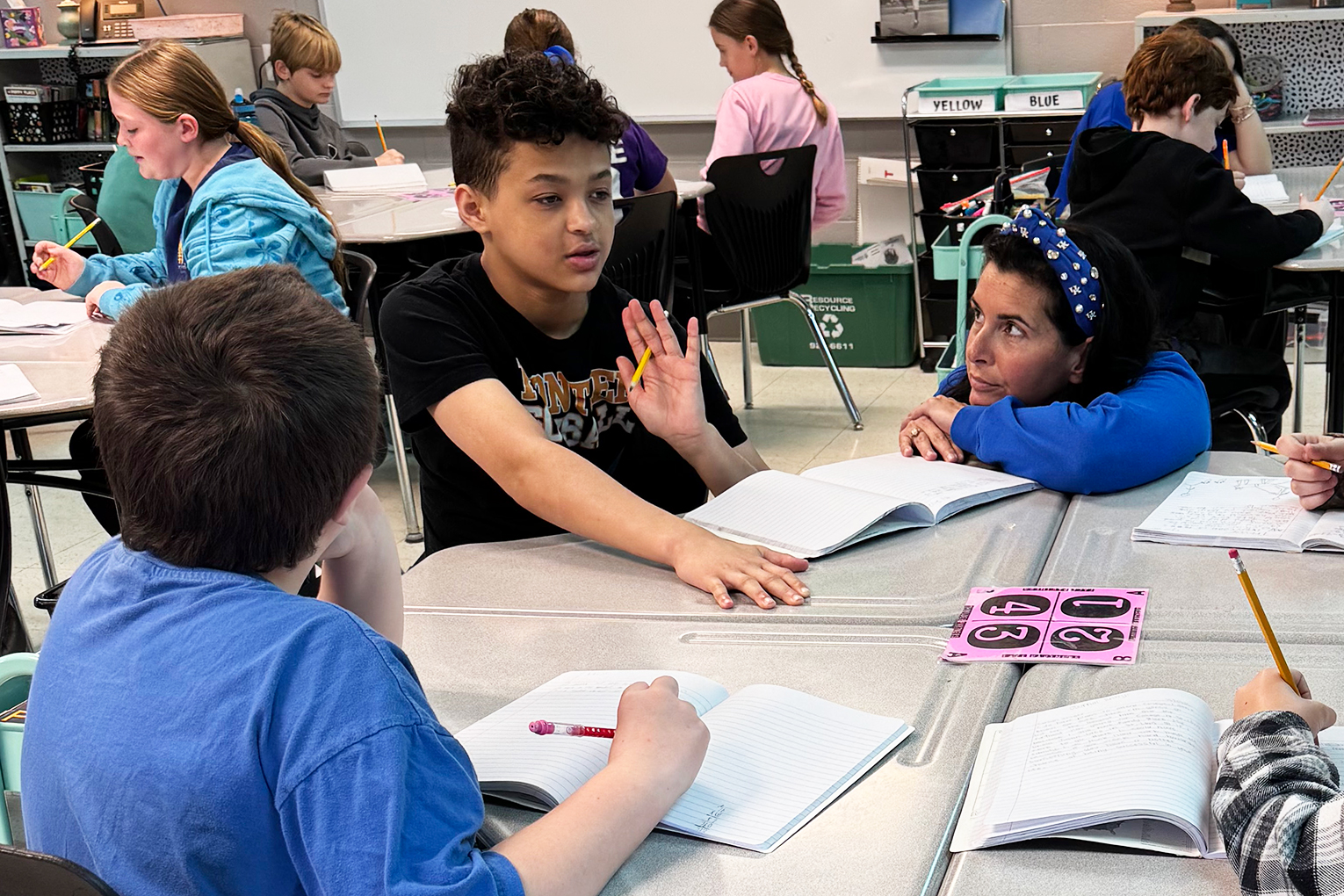
Woodford County High School social studies teacher Sioux Finney shares visual thinking strategies with Megan Sauter, student program coordinator with the Kentucky Historical Society, during training for The Right Answer program.
Photo by Amy Wallot, July 25, 2013
By Matthew Tungate
matthew.tungate@education.ky.gov
Every year that Erin McDowell shows her 4th-graders at Bridgeport Elementary School (Franklin County) a painting of Paul Revere’s famous ride, inevitably some of the students think the famous patriot has stolen something, she said. They wonder why people in the painting aren’t chasing him and if the light in the church shows where Revere was hiding.
McDowell doesn’t correct them, just drawing out their answers and asking them to defend their ideas. Then she hands them the poem Paul Revere’s Ride by Henry Wadsworth Longfellow and “they’ll go, ‘Oh that was that guy!”
“And that’s not their reading level whatsoever,” McDowell said. “A 4th-grader has no business reading that type of poem, but reading every fourth or fifth word, they’re like, ‘Oh, that’s what that was.’”
McDowell is one of several teachers who have worked informally with the Kentucky Historical Society over the last couple of years to use visual thinking strategies to help students look at artwork and other historical pieces. She is one of six teachers, trained over the summer in visual thinking strategies by a nonprofit of the same name, who will pilot a new curriculum called “The Right Answer” over the next two years.
The Kentucky Historical Society (KHS) received a $110,000 grant from the Institute of Museum and Library Services (IMLS) to create “The Right Answer.” The initiative will increase students’ skills in visual and historical literacy and critical thinking with the aid of historical collections. The program will provide schools with primary and secondary sources that can be used to teach across a broad range of disciplines, including history, social studies, government, humanities, reading, writing and fine arts.
Sioux Finney, a freshman social studies teacher at Woodford County High School, said visual thinking strategies center around three questions:
- What’s going on in this picture?
- What do you see that makes you say that?
- What more can you find?
McDowell said letting students give their own ideas about how to interpret what they see causes them to do more thinking.
“It’s OK if you don’t know the right answer, especially right away, and it just lets them think deeper,” she said. “They really are doing more thinking about it rather than just, ‘Tell me the answer so I can spit it back out for a test.”
Lindsey Harville, another 4th-grade teacher at Bridgeport Elementary, said the point of the exercise is to get students talking and listening to one another’s points of view.
“As long as they give evidence to back it up, then it’s correct,” she said.
Because of that, students who are typically quiet will speak up because they feel comfortable contributing, Harville said.
Visual thinking strategies fit right in with the speaking and listening standards in the Kentucky Core Academic Standards because students are encouraged to speak and learn civil discourse to make their point, Finney said.
She has found that visual thinking strategies engage every student.
“I’ll have students that have their heads on the desk, and we start to use visual thinking strategies and they know that whatever they see is OK, whatever they say is OK, that they bring valid points to the table. So they will gladly raise their hand and make an observation,” she said.
McDowell said students’ comments help direct her lessons.
“I like being able to see their thinking or hear their thinking so I know what misconceptions to correct when it comes time to teach, or what they already know and you can extend it,” she said.
Stephanie Wilson, a 3rd-grade teacher at Bridgeport Elementary, said using visual thinking strategies is a good way for students to start with a common knowledge about a topic, and then they will be emotionally involved and have a visual anchor for their thinking when they start reading about that topic.
“It’s just going to be really ‘meaty’ for them,’” she said.
Another part of using visual thinking strategies is for the teacher to be a facilitator, rephrasing what students have said and linking their comments together to add knowledge.
Wilson said paraphrasing is a great time to build in vocabulary words because doing so puts them in the context of what students have said.
Using visual thinking strategies forces teachers to slow down and listen to students, she said.
“I know it sounds so silly because we should be doing that with our kids, but we’re in a hurry. I’m in a hurry all day long. The way this is set up, I have to slow down. I naturally will be discussing with the children, looking at them, making sure I’m hearing what they’re saying because I have to paraphrase it back to them,” Wilson said.
McDowell said visual thinking strategies carry over from social studies, too.
“It really develops them as critical thinkers. When they’re reading, they’re reading critically, so they’re thinking and they really are aware of the thoughts they’re having as they’re reading. When they’re writing, they really do find evidence to back up what they’re saying,” she said.
McDowell said trainers recommend that teachers use three images at a time for 30-40 minutes, which she can do once per month. Finney said she uses visual thinking strategies weekly, not for 30 minutes but as a way to introduce a unit.
“It gets them kind of into the scene,” she said.
As part of “The Right Answer,” KHS staff is preparing materials for the six participating teachers to use in their classrooms and the teachers will be taking their students to the museum to use visual thinking strategies on artifacts there.
“If you want children to have an appreciation for art and to be able to look beyond just the first obvious things, this definitely is going to help,” Wilson said.
MORE INFO …
Visual thinking strategies
Leslie McWhorter, leslie.mcwhorter@ky.gov, (502) 564-1792, ext. 4424




Leave A Comment